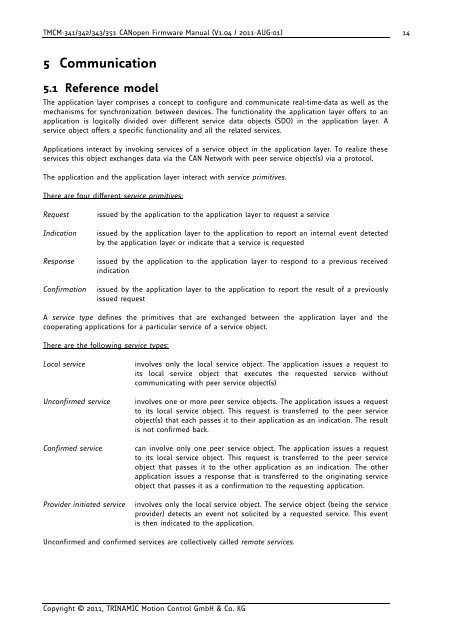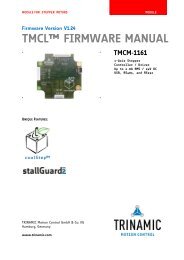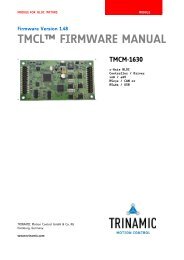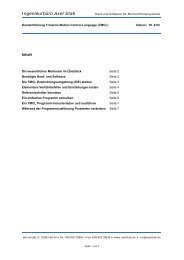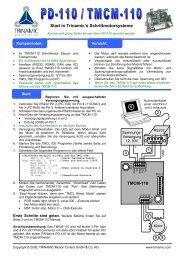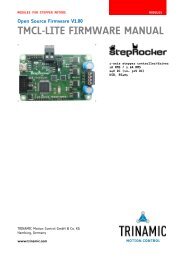TMCM-351 CANopen Firmware Manual - Trinamic
TMCM-351 CANopen Firmware Manual - Trinamic
TMCM-351 CANopen Firmware Manual - Trinamic
Create successful ePaper yourself
Turn your PDF publications into a flip-book with our unique Google optimized e-Paper software.
<strong>TMCM</strong>-341/342/343/<strong>351</strong> <strong>CANopen</strong> <strong>Firmware</strong> <strong>Manual</strong> (V1.04 / 2011-AUG-01) 14<br />
5 Communication<br />
5.1 Reference model<br />
The application layer comprises a concept to configure and communicate real-time-data as well as the<br />
mechanisms for synchronization between devices. The functionality the application layer offers to an<br />
application is logically divided over different service data objects (SDO) in the application layer. A<br />
service object offers a specific functionality and all the related services.<br />
Applications interact by invoking services of a service object in the application layer. To realize these<br />
services this object exchanges data via the CAN Network with peer service object(s) via a protocol.<br />
The application and the application layer interact with service primitives.<br />
There are four different service primitives:<br />
Request issued by the application to the application layer to request a service<br />
Indication issued by the application layer to the application to report an internal event detected<br />
by the application layer or indicate that a service is requested<br />
Response issued by the application to the application layer to respond to a previous received<br />
indication<br />
Confirmation issued by the application layer to the application to report the result of a previously<br />
issued request<br />
A service type defines the primitives that are exchanged between the application layer and the<br />
cooperating applications for a particular service of a service object.<br />
There are the following service types:<br />
Local service involves only the local service object. The application issues a request to<br />
its local service object that executes the requested service without<br />
communicating with peer service object(s)<br />
Unconfirmed service involves one or more peer service objects. The application issues a request<br />
to its local service object. This request is transferred to the peer service<br />
object(s) that each passes it to their application as an indication. The result<br />
is not confirmed back.<br />
Confirmed service can involve only one peer service object. The application issues a request<br />
to its local service object. This request is transferred to the peer service<br />
object that passes it to the other application as an indication. The other<br />
application issues a response that is transferred to the originating service<br />
object that passes it as a confirmation to the requesting application.<br />
Provider initiated service involves only the local service object. The service object (being the service<br />
provider) detects an event not solicited by a requested service. This event<br />
is then indicated to the application.<br />
Unconfirmed and confirmed services are collectively called remote services.<br />
Copyright © 2011, TRINAMIC Motion Control GmbH & Co. KG


